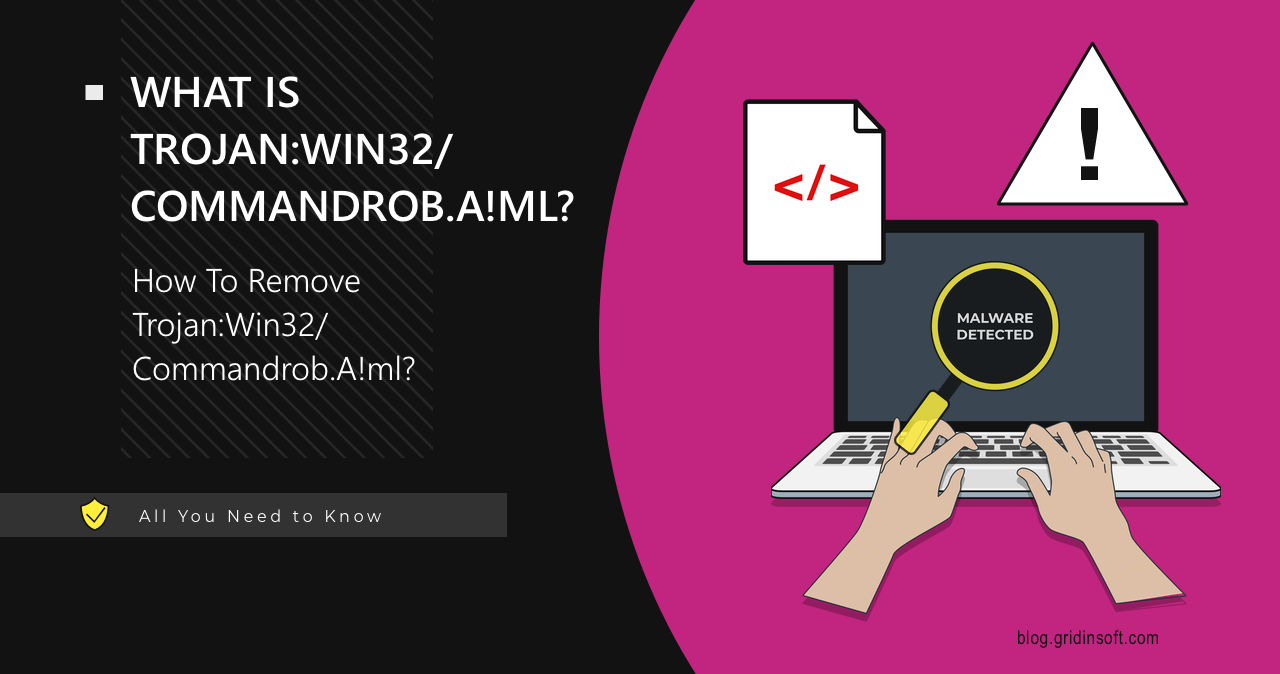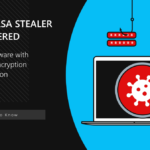Trojan:Win32/Commandrob.A!ml is a heuristic detection associated with suspicious network activity. It may refer to a wide range of malicious programs, or be a false positive detection. In this post, I will explain what it means and how you can check the system for possible viruses.
Trojan:Win32/Commandrob.A!ml Overview
Trojan:Win32/Commandrob.A!ml is an AI-based detection of Microsoft Defender. This detection is triggered by behaviors typical of spyware or backdoors that access network resources. Since the detection relies on machine learning (indicated by the “!ml” suffix), it may be a false positive. This happens because the detection focuses on program behavior and network communication patterns instead of traditional signature-based analysis.
This creates a significant uncertainty for users who see this detection. Even legitimate programs can be detected, but at the same time, that does not guarantee that one sees a false positive. There are quite a lot of details to go through to understand whether this detection carries any danger for your system, so let’s have a more detailed look at what exactly is detected.
Technical Analysis
As mentioned earlier, Trojan:Win32/Commandrob.A!ml is a behavior-based heuristic detection. In particular, users report about it flagging a PowerShell script used for specific network operations. Calls used in these scripts can indeed be attributed to backdoors or spyware: they typically query the system’s IP address to detect system location. Malware needs this info to avoid running certain countries and communicate with command servers. In particular, the following command is almost guaranteed to cause the detection:
(Invoke-WebRequest -uri http://ipinfo.io/ip -UseBasicParsing).Content
This request queries the external IP address of the host system by invoking the “ipinfo.io” service, which returns the IP address in plaintext. The -UseBasicParsing option streamlines web response parsing, making it faster and less reliant on Internet Explorer’s full HTML parsing, which older PowerShell versions may use by default. The “Content” property retrieves the HTTP response body, which in this case contains the external IP address of the system.
Such behavior, as I’ve mentioned, is pretty typical for spyware and backdoors, though can be found in other malware types. Anyways, malware uses this information to create a system fingerprint, and sometimes stop further execution if the detected location is in the ban list. Though, if the Trojan:Win32/Commandrob.A!ml is a real detection, you won’t see all the commands and arguments like that, in plain text, as it would be extremely easy to detect. Malicious programs employ encoding to avoid this, making the command unintelligible.
The effects of the Trojan:Win32/Commandrob.A!ml (if it is a real malware) are less than pleasant. Regardless of the exact type, the virus will likely gather all the login credentials present in the system, and provide remote access for the hacker. You may not notice that instantly, but in about a week, the hackers will make use of the leaked passwords and hijack the corresponding accounts. Aside from the dirty job with passwords, it will likely disable security measures of the system, making it vulnerable to further malware attacks.
Is Trojan:Win32/Commandrob.A!ml False Positive?
There is a high probability of Trojan:Win32/Commandrob.A!ml being a false positive detection. Since the detection is triggered by network communications via PowerShell, legitimate programs often use similar commands to carry out routine tasks. Examples include software updates or network status checks – a thing present in a lot of modern software.
One specific example comes from the Peugeot community forum, where the user reported this detection flagging the new firmware for the on-board computer of a Peugeot car. As they’ve sourced the firmware from the official website, chances of it being a real detection are, obviously, extremely low. All that users can do in such situations is to add the corresponding file to the Ignore List, so Microsoft Defender won’t touch them.
Overall, if you see the Trojan:Win32/Commandrob.A!ml detection popping up to a safe and legitimate program, it will be OK to just ignore and whitelist it. Microsoft typically updates its detection databases every day, so the fixed version will likely appear in a day or two. At the same time, it may at times be difficult to make a decision, especially when the Defender flags a PowerShell instance or a random file, not a specific program.
How to Remove Trojan:Win32/Commandrob.A!ml?
To scan the system and remove the potential Trojan:Win32/Commandrob.A!ml malware, I recommend using GridinSoft Anti-Malware. It will give you the second opinion on whether there is anything malicious going on in your system, and remove the threats in just a few clicks. A Full scan will fit the need, scanning even the most remote parts of the system. The program will also help with stopping threats like Trojan:Win32/Commandrob.A!ml in future.

Download and install Anti-Malware by clicking the button below. After the installation, run a Full scan: this will check all the volumes present in the system, including hidden folders and system files. Scanning will take around 15 minutes.
After the scan, you will see the list of detected malicious and unwanted elements. It is possible to adjust the actions that the antimalware program does to each element: click "Advanced mode" and see the options in the drop-down menus. You can also see extended information about each detection - malware type, effects and potential source of infection.

Click "Clean Now" to start the removal process. Important: removal process may take several minutes when there are a lot of detections. Do not interrupt this process, and you will get your system as clean as new.






great writeup with examples. now i know why google update is raising suspicious activities